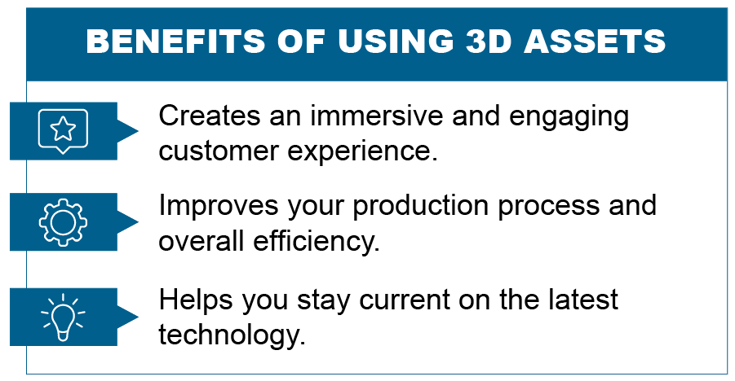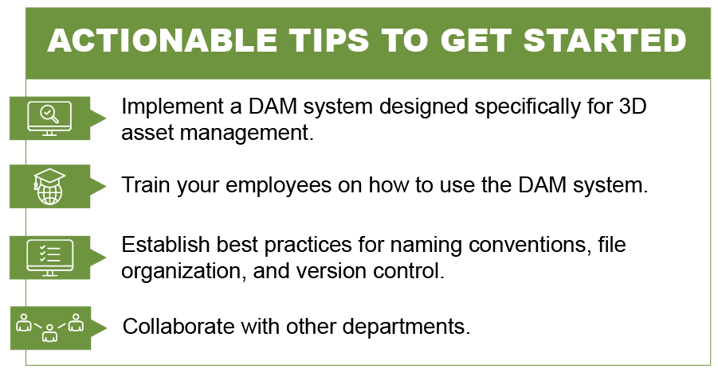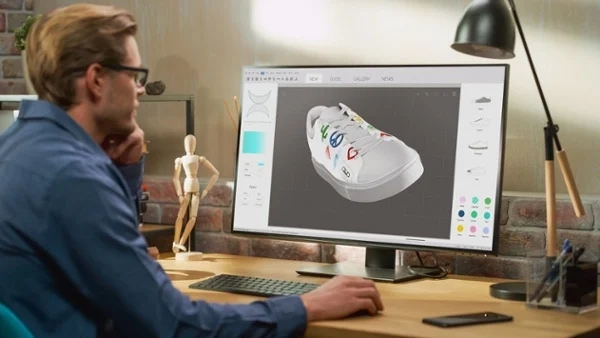What is PAM? Everything you need to know about Product Asset Management
A Product Asset Management solution is the next generation of Digital Asset Management (DAM). Product Asset Management connects content, data, and...
4 min read
 Matt Astarita, Product Manager at Hyland's Nuxeo
:
Jul 12, 2023
Matt Astarita, Product Manager at Hyland's Nuxeo
:
Jul 12, 2023

In our previous post, 3D Asset Values: The Benefits of Implementing a DAM System, we explored key features of Digital Asset Management (DAM) systems for 3D asset management for creating, storing, and searching 3D assets in a DAM system. In this post, we look at the final two topics:
Online Channels
You can easily integrate 3D assets into e-commerce platforms like Magento or Shopify using a DAM system with direct integration to showcase your products in a more immersive way. As with many retailers online, you can browse for items and use them to see how they look inside your home.
Physical Channels
While online channels are important, physical channels are still important in certain industries, such as the fashion industry.
A DAM system makes managing and distributing 3D assets for print materials such as flyers and posters simple. With a DAM system, you can connect to creative tools like InDesign to create the assets and make them ready to be printed. Consider incorporating augmented reality (AR) into your print materials to give customers a more immersive experience.
With the right access control, you can efficiently distribute your 3D assets to retailers so they can showcase your products in their physical stores using a DAM system. They can use tablets or even virtual try-ons to display the 3D versions of your products.
Regardless of whether you distribute online or offline, make use of analytics. You can easily track the success of your 3D asset distribution efforts and make data-driven decisions for future campaigns when you use a DAM system. Consider tracking engagement and conversion rates with the appropriate analytics tools.
As a takeaway, a DAM system allows you to efficiently manage and distribute consistent 3D assets across multiple channels. This will help you improve brand recognition and customer satisfaction.

Are you ready to take your brand to the next level of customer experience?
You finished creating a 3D representation of a product, let's say sneakers. You can reuse that very same 3D asset to enhance your Brand Experience. Remember how those assets will be used when storing 3D assets in a DAM system. For example, it may be beneficial to organize assets according to a product category or experience type (e.g., virtual store, virtual try-on).
Creating virtual store experiences is one way to use 3D assets in the fashion and e-commerce industries. Customers can explore products in a more immersive way by seeing how they appear in a 3D environment in virtual stores.
For example, a virtual store may include 3D renderings of a physical store's space, allowing customers to "walk" through the store and view products in 3D to showcase products in a unique and engaging way.
Creating virtual try-on experiences is another way to use 3D assets in the fashion and e-commerce industries. Customers can use virtual try-on to see how products will look on them without having to try them on physically. This is especially useful for products such as eyewear or jewelry, where fit and style are critical considerations. Customers can see how products will look on them in a more realistic and engaging way by using 3D assets to create a virtual try-on.
Finally, creating NFTs is another way to use 3D assets in the fashion and e-commerce industries (non-fungible tokens). NFTs are digital assets that can be bought and sold in the same way that traditional assets can, but they are one-of-a-kind and cannot be replicated.
Fashion and e-commerce companies can tap into the growing market for digital collectibles by creating 3D assets as NFTs. A company, for example, may create NFTs of limited edition products or unique 3D designs that can be purchased and sold on a blockchain marketplace.
Fashion and e-commerce companies can more effectively manage and utilize 3D assets by storing them in a DAM system for virtual store experiences, virtual try-ons, and even as NFTs. The possibilities for using 3D assets in the fashion and e-commerce industries will only grow as technology advances.
To wrap up this two-part series, here are some final thoughts on putting a DAM system at the heart of your 3D content's digital supply chain. We've seen the main advantages, but here are three key points to remember:

For more info on the benefits of integrating a DAM system, check out our previous blog:
About the Author
Genus guest blogger Matt Astarita specializes in Product Management at Hyland's Nuxeo. Matt is passionate about creating digital products that drive innovation and add value to people's lives. Throughout his career, he has developed a deep understanding of the product development process and continues to hone his skills in identifying market needs, conducting market research, and creating strategic product roadmaps. Connect with Matt on LinkedIn!
Get more useful content, expert tech tips, and timely articles delivered to your inbox ~ Subscribe to Genus Insights!

A Product Asset Management solution is the next generation of Digital Asset Management (DAM). Product Asset Management connects content, data, and...

Are you sure you're ready to scale the creation and use of 3D assets across your organization?You've already transitioned from a physical to a...

In our previous Insights article, Explore Advanced DAM Solutions and Maximize the Value of Your Content, we explored the evolution of DAM and how to...